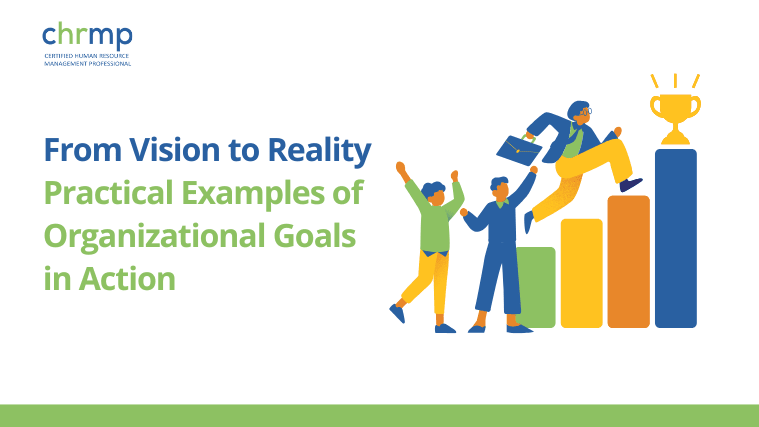
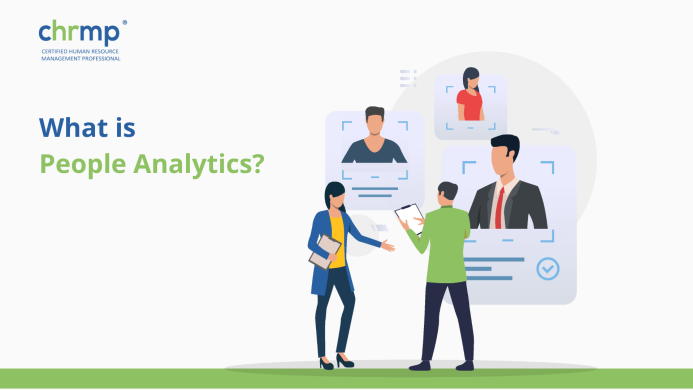
The world of people analytics is exciting. Well, to begin with, it involves data and people-related issues that crop up in the workplace. Using concrete data to manipulate something as intangible as people’s behaviour to promote productivity and improve organisational financial metrics is undoubtedly fascinating.
So whether you’re an HR professional or just someone who wants to know more about the fascinating field of data analytics, you’re in for a treat!
People analytics is all about using data to improve people-related issues regarding productivity, engagement, compensation, training and development and career growth in the workplace. It’s a growing field that changes how businesses operate and helps create a more data-driven approach to HR.
In this blog post, we’ll explore the basics of people analytics, its benefits, and how you can get started with this exciting field.
So, let’s dive in!
People analytics, also called HR analytics or workforce analytics, is the process of using data to make more informed decisions about people-related issues in the workplace. This includes analysing employee performance, engagement, retention, absenteeism, turnover, recruitment, skills gap, training and development and other factors that impact workforce management.
It uses data science, statistics, algorithms and machine learning techniques to identify patterns and insights in employee data that can help organisations make more effective people-related decisions to enhance productivity and financial metrics like revenue, sales, and profits at the organisational level.
By leveraging it, organisations can improve their recruitment and retention strategies, enhance employee engagement, reduce turnover, costs and, ultimately, drive business to greater levels.
People analytics is essential for several reasons.
Firstly, it allows organisations to make data-driven decisions that are not based on intuition about their workforce. This can lead to more efficient and effective HR practices to retain top talent and have a more engaged workforce. Organisations can identify patterns, correlations and trends by analysing employee data to help make informed decisions on recruitment, training, promotion, compensation and performance management.
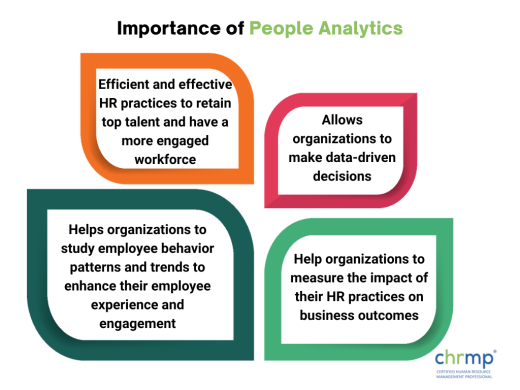
Secondly, people analytics helps organisations study employee behaviour patterns and trends to enhance employee experience and engagement. Organisations can create more tailored programs and initiatives that increase employee satisfaction, engagement and retention by using data to understand what motivates the workforce and drives their engagement.
Lastly, people analytics can help organisations measure their HR practices’ impact on business outcomes, such as productivity, revenue, customer satisfaction and brand loyalty. By demonstrating the value of HR initiatives in quantifiable and measurable terms, organisations can secure buy-in from stakeholders and justify their investment in HR programs.
As the use of data becomes more prevalent in every aspect of business, it’s no surprise that people analytics is rapidly gaining popularity. With its ability to provide insights into employee behaviour, engagement, and performance, people analytics is becoming an essential tool for modern HR departments.
Some key benefits of people analytics include:
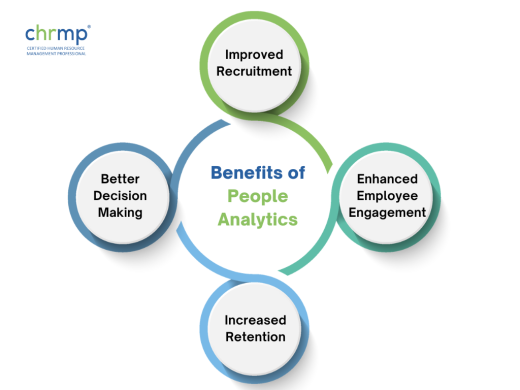
1.Improved Recruitment: By using people analytics, organisations can identify the traits and characteristics in an individual most likely to lead him to success in a particular role. This allows HR departments to make more informed hiring decisions, which are cost-effective, leading to better recruitment outcomes and reducing the risk of bad hires.
2.Enhanced Employee Engagement: People analytics can provide insights into employee behaviour, satisfaction, and motivation. This information can be used to create more effective engagement programs tailored to meet the specific needs of employees, which leads to employees’ job satisfaction, low turnover rates, less absenteeism, more engagement and productivity, and a cost-effective workforce.
3. Increased Retention: By identifying the factors that lead to high employee turnovers, such as dissatisfaction with pay, benefits, welfare amenities, or work-life balance, organisations can take proactive measures to retain their employees. Retaining the more talented and productive ones is always more cost-effective than hiring fresh talent now and then and training them in work mode. If companies could provide more competitive compensation packages, improve work-life balance, and provide opportunities for professional development and better welfare amenities, retention of top talent would become more accessible.
4. Better Decision Making: People analytics enables HR departments to make data-driven and informed decisions about their workforce, not intuitive ones. By using data to make informed decisions on recruitment, promotion, performance management, and training, organisations can motivate and inspire employees, which leads to better business outcomes.
Implementing people analytics can be a complex process. But by following a few simple steps, organisations can successfully implement a people analytics program and start reaping the benefits of data-driven decision-making.
Let’s explore the five steps to implementing people analytics.
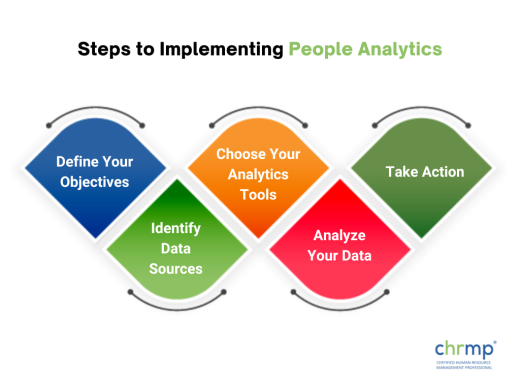
The first step to implementing people analytics is to define your objective, i.e. the goal. What do you hope to achieve by using people analytics, including improved recruitment, increased employee engagement, or reduced turnover and absenteeism? Clear objectives will help you to identify the data you need to collect and the metrics you need to measure to achieve your goals.
The next step is identifying the data sources you will use for your people analytics program. This could include HR systems, performance data, engagement surveys, customer surveys or external data sources. It’s essential to ensure that your data is accurate, relevant, and up-to-date, as this will ensure that your insights are accurate, which will help you achieve your objective.
Once data source identification is over, the next step is to choose your analytics tool carefully. Various analytical tools are available, from simple spreadsheets to more complex devices that use machine learning algorithms. Choosing a tool that is tailored to meet your specific needs and is easy to use is essential.
The fourth step is to analyse your data. This involves identifying patterns, trends and correlations in your data to help you make informed decisions. There should be no room for ambiguity. It’s essential to ensure that your analysis is accurate and that your insights are based on objective data.
The final step is to take action based on the insight you gleaned from reading your data. Data analysis and interpretation involve techniques from data science, statistics, algorithms and machine learning. Next comes implementing the new recruitment strategies, creating more effective engagement programs, or adjusting compensation packages which should be tailor-made to suit your organisational needs. One size fits all policy never works. It’s important to monitor the impact of your programs, initiative, and drives and make adjustments as and when needed to ensure that you achieve your objectives.
The future of people analytics seems very promising, with data’s increasing importance and availability and the development of new analytics tools and techniques. Key trends include the rise of predictive analytics, the use of artificial intelligence, and a growing focus on employee well-being, inclusion and work-life balance.
By leveraging people analytics to focus on employee well-being and inclusion, organisations can identify and address areas of bias (based on religion, gender, age, and income)or inequality within their workforce. For example, people analytics can analyse recruitment, promotion and compensation patterns to ensure that opportunities are distributed fairly and evenly.
As organisations continue to invest in people analytics and explore new applications of these tools and techniques, the potential to drive positive change in the work environment and improve business outcomes is tremendous.
People analytics and HR analytics are related but distinct fields, with some overlap in their focus and methods.
Here are some key areas where they differ:
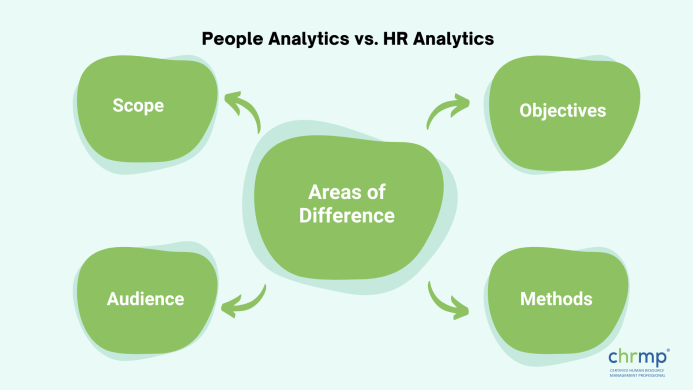
People analytics and HR analytics are related but distinct fields, with some overlap in their focus and methods.
Here are some key areas where they differ:
1.Scope:
People analytics is a broader field that encompasses the analysis of all aspects of people-related data, including HR data and data from other sources such as sales, operations, and finance. In contrast, HR analytics focuses specifically on analysing HR data, such as employee demographics, turnover, performance, and compensation.
2.Objectives:
People analytics is focused on using data insights to optimise business outcomes, including improving employee performance and engagement, reducing costs, and increasing revenue. HR analytics is focused on optimising HR processes, such as recruitment, talent management, and performance management, with the goal of improving the overall effectiveness of HR.
3.Methods:
People analytics often uses a broader range of data analysis methods, such as predictive analytics, machine learning, and natural language processing, to gain insights from complex and unstructured data. HR analytics typically uses more traditional statistical methods, such as regression analysis and correlation analysis, to analyse structured HR data.
4. Audience:
People analytics is often targeted at senior executives and business leaders who are interested in using data insights to drive strategic decision-making across the organisation. HR analytics is often targeted at HR professionals who are interested in using data insights to improve HR processes and policies.
In summary, people analytics is a more expansive field that goes beyond HR data and is focused on optimising business outcomes, while HR analytics is more narrowly focused on analysing HR data to improve HR processes and policies.
1.What is the difference between HR analytics and people analytics?
HR analytics typically focuses on analysing HR-specific data such as employee demographics, turnover rates, and recruitment metrics. People analytics, on the other hand, incorporates a wider range of data sources, including employee feedback, sentiment analysis, and performance data, to help organisations understand and optimise their workforce.
2.What are some common use cases for people analytics?
Common use cases for people analytics include talent acquisition, employee engagement and retention, diversity and inclusion, and leadership development.
3.What are some ethical considerations that organisations should keep in mind when using people analytics?
Organisations should be transparent about what data they are collecting and how they plan to use it. They should also ensure that any data used in people analytics is accurate and up-to-date and take steps to protect employee privacy.
4.What skills do you need to work in people analytics?
Working in people analytics requires a blend of technical and soft skills. You should have a good understanding of statistics, data analysis, and data visualisation tools, as well as strong communication and collaboration skills.
5.What are some common challenges organisations face when implementing people analytics?
Some common challenges include getting buy-in from senior leadership, ensuring that data is accurate and up-to-date, and creating a culture of data-driven decision-making across the organisation. Additionally, organisations must be prepared to continuously evolve their people analytics approach as new data sources and tools become available.
In conclusion, people analytics is an exciting and rapidly-evolving field that has the potential to transform HR management methods and improve business outcomes.
By leveraging data and analytics tools, organisations can gain insights into the dynamics of their workforce that they might not be able to access through traditional methods.
The use of techniques from data science, statistics, algorithms, and machine learning helps HR managers in extrapolating data patterns and predicting workforce future behaviour, then prescribing and implementing initiatives, drives and programs accordingly.
The future of people analytics is bright, with trends such as the use of predictive analytics, and artificial intelligence and a growing focus on employee well-being and inclusion.
By embracing people analytics and investing in the necessary tools and skills, organisations can create a more data-driven, accurate, efficient, and effective HR function that delivers value to the business and helps employees and the financial aspects of business to thrive.
© 2007-2025 CHRMP| All Rights Reserved | Powered by Ripples Learning & Research Private Limited
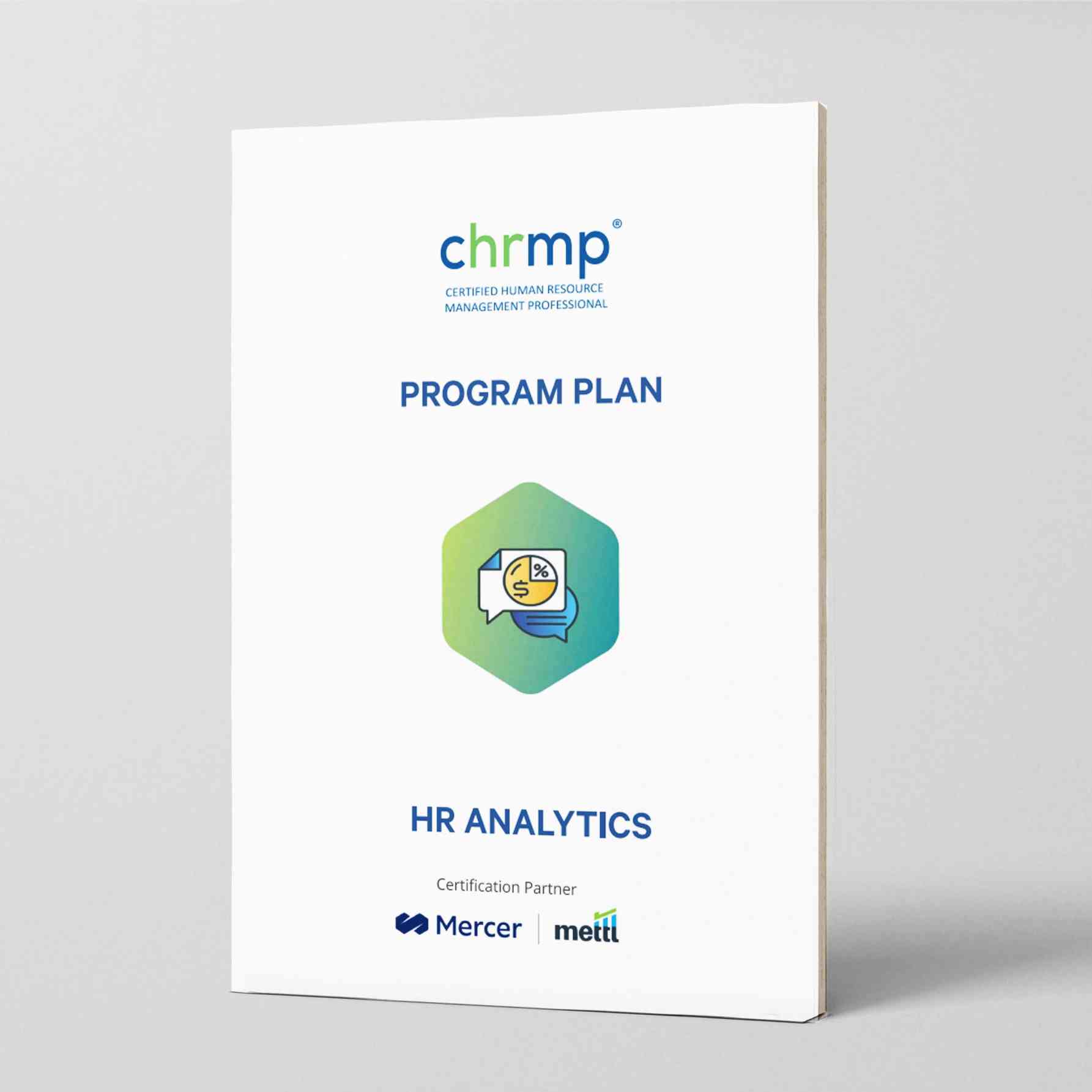
Fill in the below details to get a CHRMP HR Analytics Program Plan.
